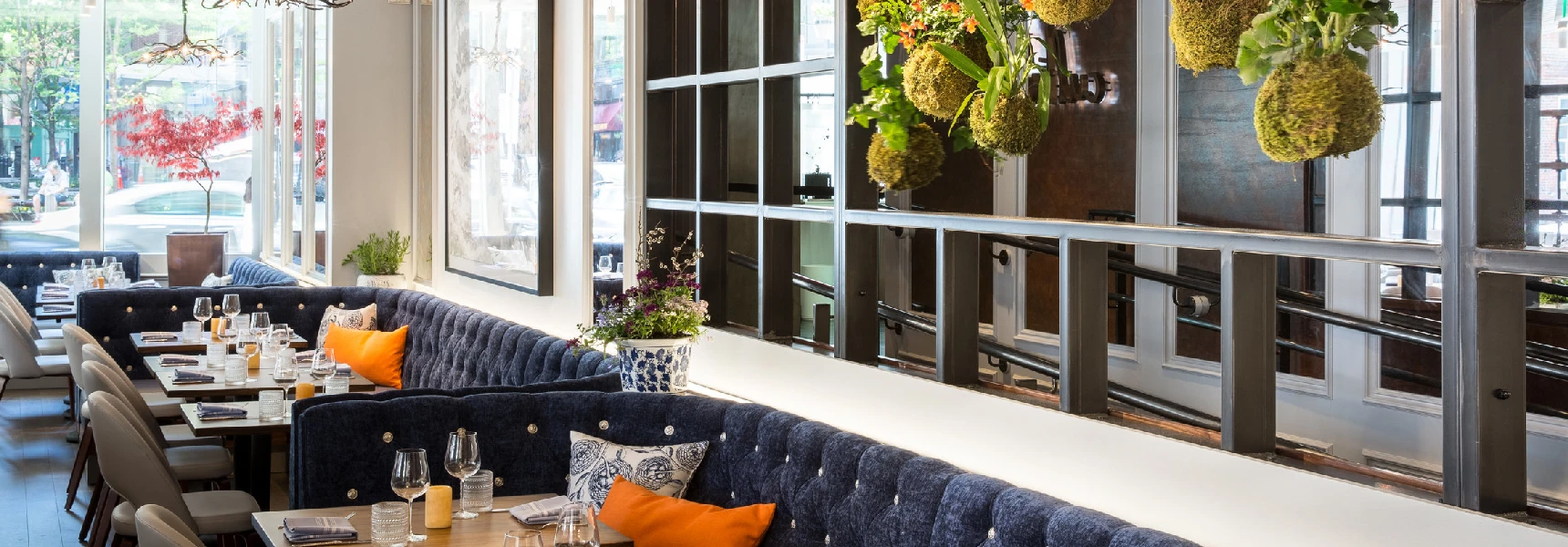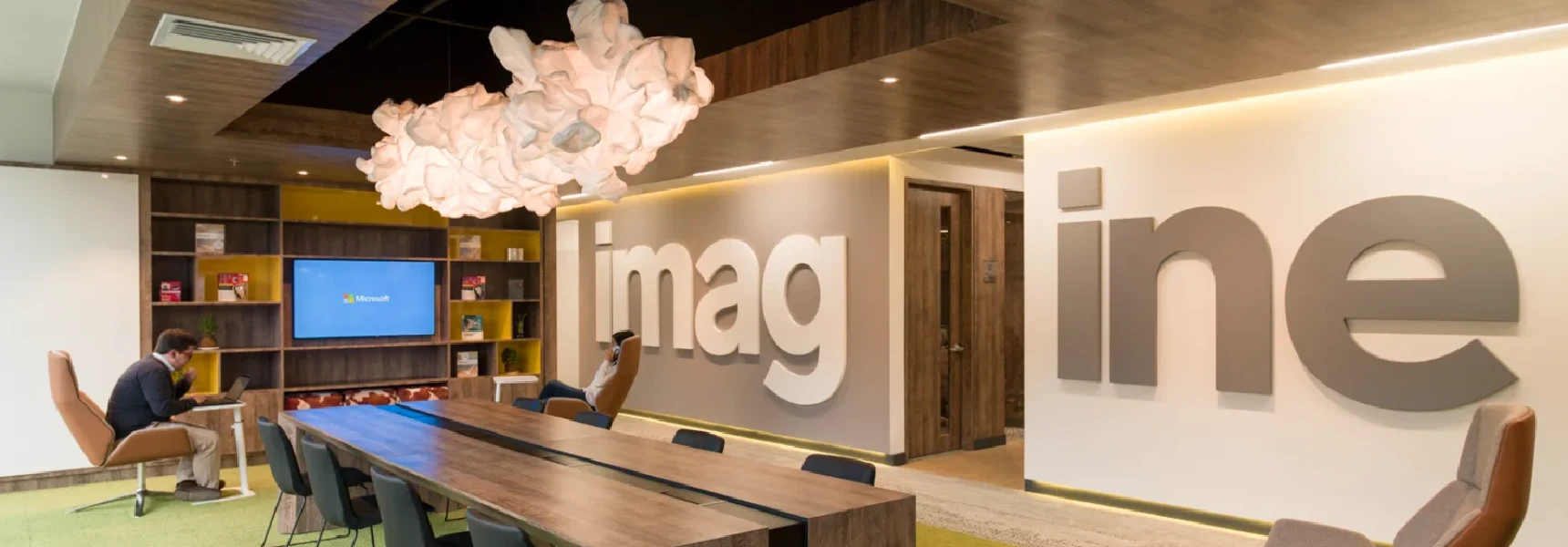Innovation
Top Office Design Trends in Florida for 2025: What Project Managers Should Know
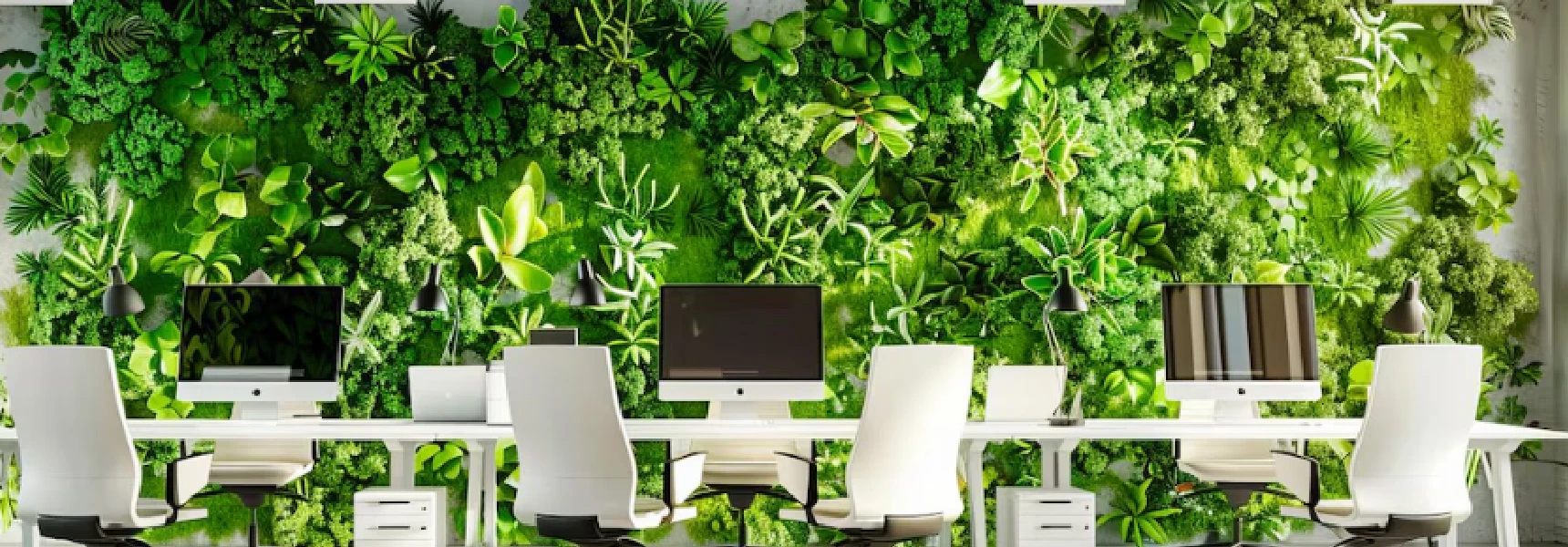
Florida’s office landscape is rapidly evolving to meet the demands of a post-pandemic, hybrid-working world. As we head into 2025, project managers planning office transformations must stay abreast of the latest workplace trends. These trends—ranging from flexible layouts to wellness-focused amenities—are not just buzzwords; they’re strategic investments that boost efficiency, collaboration, employee well-being, and long-term ROI. Below, we explore the top Florida office design trends of 2025 and how each benefits project managers overseeing modern office interior projects in the Sunshine State.
1. Flexible Hybrid Workspaces and Hot-Desking
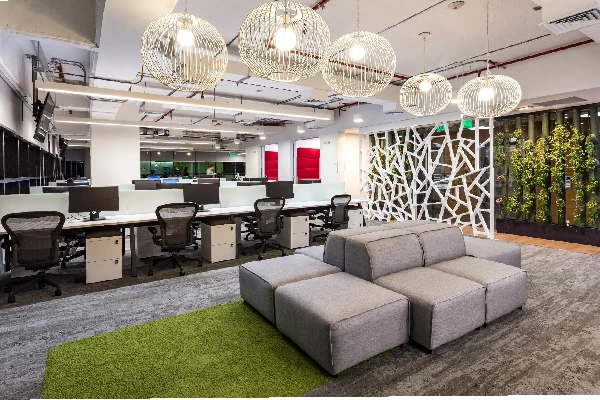
Florida offices are embracing flexibility. In the photo above, employees collaborate in a casual lounge area and greenery – a multipurpose spaces. Modern Florida office design is heavily influenced by hybrid work patterns. With many employees not coming in five days a week, companies are rethinking the traditional sea of cubicles. Hot-desking – where no one has an assigned seat – has become a game-changer for hybrid teams. By “floating” staff to different available workstations each day, organizations can reduce the number of empty desks, cut real estate overhead, and foster spontaneous interactions that spark creativity. Project managers will appreciate how this efficient use of space lowers costs and maximizes office utilization on any given day.
Beyond desk-sharing, the emphasis is on adaptable layouts that balance open and private areas. Forward-thinking firms are moving away from one-size-fits-all floorplans and instead offering a variety of zones: casual sofas and huddle areas for teamwork, enclosed nooks or pods for focused work, and movable furniture that can be reconfigured on the fly. This approach gives employees the freedom to choose an environment that suits their task—be it a brainstorming session or deep concentration. For project managers, such flexibility means an office can easily be re-zoned to accommodate changing team sizes or new functions without major renovations. Notably, some Florida companies have even managed to downsize their overall footprint by designing smarter multipurpose spaces; for example, one Miami design studio delivered the same functionality in 60% of its previous office space by prioritizing shared collaboration areas and eliminating underused corners. The result is a dynamic workplace that can evolve with the company’s needs – a big win for long-term ROI and future-proofing.
2. Employee Well-Being and Experience at the Core
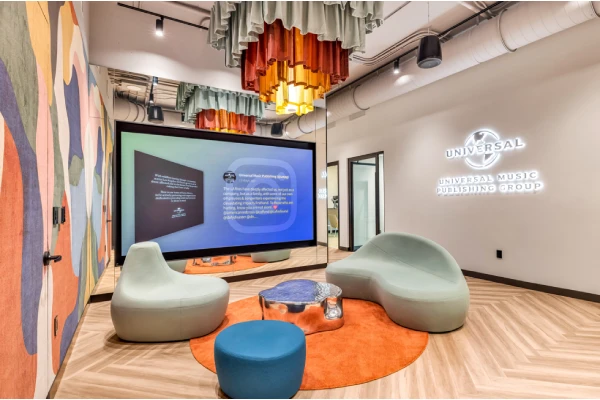
Workplace wellness is front-and-center in 2025 office interiors. Above, an employee takes a meditation break on a stability ball in a dedicated quiet corner – a perfect example of an amenity designed to reduce stress and improve well-being on the job. Convincing employees to return to the office regularly means making the workplace as inviting and supportive as possible. In 2025, employee-centric design is all about amenities and features that boost health, happiness, and morale. We’re not just talking about the token coffee pot in the break room anymore – Florida offices are adding full barista-style coffee bars, onsite fitness rooms or yoga wellness rooms, game areas (think ping-pong or console gaming), and comfortable lounges that feel like home. These perks help transform the office from a place you have to be into a place you want to be.
Crucially, companies are also investing in ergonomics and comfort to support employees day-to-day. Adjustable standing desks, supportive seating, and human-centric lighting systems that mimic natural daylight are becoming standard. Such upgrades make the transition from home office to corporate office less jarring, reducing fatigue and improving posture and focus. By prioritizing wellness and comfort, employers enable their people to thrive mentally and physically on-site – and the payoff is real. Studies show that thoughtful office design can boost productivity by up to 20%. Likewise, workplaces with health-focused features report higher employee satisfaction and retention. For project managers, these stats underscore a key point: designing with well-being in mind isn’t just altruistic, it’s a strategic move that enhances performance and keeps talent engaged. In Florida’s competitive job market, offering amenities like meditation rooms, outdoor break patios, or even on-site childcare can differentiate your company and help attract top talent. Remember, today’s tenants and employees increasingly seek offices that blend work and life, providing conveniences such as gyms, cafés, and green spaces under one roof. Incorporating these elements will lead to a happier team and, in turn, more effective project execution.
3. Biophilic Design and Sustainable Materials
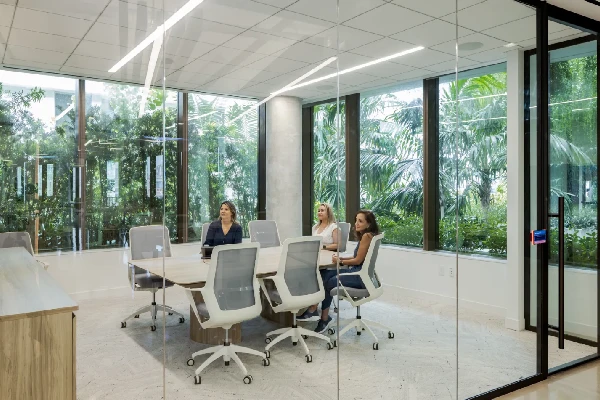
Nature meets the office: A modern Florida workspace features an actual tree and abundant greenery indoors, paired with open layout and natural materials. Biophilic touches like this not only create a wow factor but also have measurable benefits for well-being and focus. One of the most visible workplace trends 2025 is the infusion of nature and sustainability into office interiors – a particularly fitting development in the Sunshine State. Biophilic design, which means integrating natural elements into the built environment, has proven benefits for reducing stress and improving mood. In Florida offices, this trend shows up as indoor gardens and living plant walls, desks made from reclaimed wood, nature-inspired color palettes, and big windows that let in plenty of sunlight. Companies are adding lush greenery and even water features to create calming environments that remind people of the outdoors. By weaving plants and natural textures into conference rooms, lobbies, and break areas, employers make the transition back to office life far more inviting. For instance, a cutting-edge office in Coral Gables designed for the future features a “garden lounge” with air-cleaning tropical plants and 19-foot ceilings – flooding the space with daylight and giving staff a direct connection to nature that enhances productivity and uplifts spirits.
Equally important is the focus on sustainable design choices. Florida project managers are keenly aware of environmental responsibility, especially as climate concerns grow. In practice, this means opting for eco-friendly materials (like bamboo flooring or recycled fabric partitions) and energy-efficient fixtures. Installing LED lighting and smart HVAC systems can dramatically cut energy use and operating costs over time. Some offices are pursuing LEED certifications or wellness ratings, ensuring everything from low-VOC paint to advanced air filtration (a must-have in Florida’s humid climate to maintain good indoor air quality). These green initiatives aren’t just good for the planet – they send a positive message to employees and clients. By using sustainable materials or providing recycling stations and water-saving fixtures, you show your team that you’re serious about a healthier, more responsible workplace. And that seriousness pays off: an eco-conscious office can reinforce company values and appeal to clients who prioritize sustainability. Importantly for project managers, many green features also contribute to long-term ROI by lowering utility bills and even hardening the office against Florida’s environmental challenges. For example, impact-resistant glass can protect your space (and people) during storms while still allowing in ample natural light. In short, blending biophilic design with sustainability creates offices that look stylish, feel good to work in, and cost less to run over the long haul – truly a win-win in 2025.
4. Technology-Integrated “Smart” Offices

In 2025, a modern office interior is as much a tech platform as it is a physical space. Florida’s booming tech and finance sectors are fueling demand for smart offices loaded with the latest gadgets and connectivity. For project managers, integrating technology into the design isn’t optional – it’s essential for efficiency and future-proofing. Smart building systems can automatically adjust lighting and climate controls based on occupancy and time of day, optimizing energy usage and employee comfort. Imagine lights that dim when sunshine is pouring in, or AC that kicks in only in occupied rooms. These innovations reduce waste (cutting costs) and create a more comfortable, user-friendly environment. IoT sensors are also becoming commonplace, monitoring everything from air quality to room occupancy. In a Florida office, a sensor might detect humidity rising and signal the ventilation system to dehumidify, keeping the space crisp and mold-free – a subtle but critical benefit in our climate.
Another tech trend project managers should prioritize is outfitting the workplace for seamless hybrid collaboration. This means dedicating spaces and equipment for high-quality video conferencing, interactive whiteboards, and robust network infrastructure. Many Florida conference rooms now come with ultra-fast Wi-Fi, large smart screens, and integrated audio systems to ensure meetings can include remote team members without a hitch. Advanced conferencing tech, such as 360-degree cameras or VR collaboration tools, helps bridge the gap between in-office and remote staff, boosting overall team collaboration. Additionally, touchless technologies that rose to prominence during the pandemic – like app-based door access, motion-sensor faucets, and voice-activated elevators – are continuing to gain traction for both health and convenience. They signal a forward-thinking office and also streamline daily workflows (no more keycards to manage, for example).
Florida companies at the forefront of this trend are leveraging smart offices to attract top talent, especially among younger professionals who expect a tech-savvy workplace. As one construction report notes, as competition for talent intensifies, businesses are using high-tech office spaces to create environments that support collaboration and creativity. In other words, a cutting-edge office can be a recruiting tool. For project managers, investing in technology upfront can yield significant long-term ROI: smarter energy management lowers bills, and digital booking systems or occupancy analytics can inform better space planning decisions over time. Plus, a well-wired office is easier to adapt to new tech in the future. By partnering with IT early in the design process, you can ensure your Florida office design includes the infrastructure for tomorrow’s innovations—whether that’s AI-driven facility management or new collaboration platforms. The bottom line: integrating tech into design makes your office more efficient, adaptable, and appealing for years to come.
5. Designing for Collaboration and Long-Term ROI
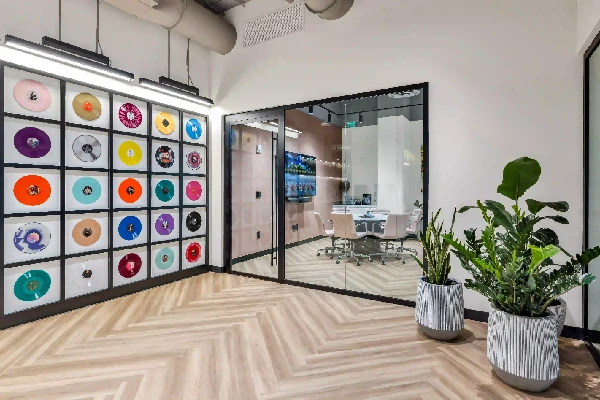
All of the trends above ultimately serve a common purpose: to create workplaces that enable people to work together effectively and drive better business outcomes. Collaborative design is a thread running through flexible layouts, wellness amenities, biophilic elements, and tech integration. By providing a mix of informal gathering spots, formal meeting rooms, and digital collaboration tools, Florida offices are breaking down silos and sparking innovation. Open café-style areas encourage cross-department chats that might not happen in a traditional cubicle setup, while dedicated project “war rooms” or brainstorming lounges give teams space to create and problem-solve together. Collaboration isn’t just about open space, though – it’s also about thoughtful acoustics and privacy where needed. Many offices are adding soundproof phone booths or focus rooms so that employees have quiet options for intensive tasks. This balanced approach addresses one of the biggest complaints of old all-open offices (distractions) while still preserving the benefits of openness (visibility and easy communication).
From a project manager’s perspective, a well-designed collaborative environment directly contributes to project success. Teams that can easily meet, whether in person or via top-notch virtual meeting setups, are more likely to stay aligned and hit their milestones. Moreover, an office that promotes a positive workplace culture – through social spaces, brand-inspired design elements, and shared amenities – can improve morale and reduce turnover. High employee retention means less time and money spent on recruiting and training new staff, which is another form of ROI not to be underestimated. There’s also a real estate ROI angle: flexible and efficient designs can potentially allow your company to operate in a smaller, more cost-effective space without compromising functionality, as demonstrated earlier. And should the company grow, adaptable interiors make expansions or reconfigurations far less costly than a full redesign.
In Florida, some firms are even embracing mixed-use concepts, situating offices in developments that offer restaurants, parks, or retail on-site, thereby increasing convenience for employees and adding value to the property. While not every project manager will have a say in the building location, it’s worth noting how these macro trends can influence the desirability of your office project. At minimum, incorporating amenities like on-site food options or outdoor terraces where possible can mimic that mixed-use appeal and enhance employee satisfaction. Ultimately, every trend circles back to ROI – whether it’s financial returns from energy savings and space optimization or human returns in the form of engaged, productive teams. By championing these design trends in your 2025 office project, you’re not just creating a beautiful space; you’re building a work environment primed to support your organization’s goals well into the future.
6. Partnering for Success in Modern Office Interiors
As a project manager in Florida, staying on top of these workplace trends 2025 is key to delivering an office space that’s efficient, collaborative, and healthy for your team. From Fort Lauderdale to Tampa and Miami to Orlando, companies across the state are seeing the benefits of flexible layouts, wellness-driven design, natural elements, and smart technology in their workplaces. The common thread is clear: when an office is designed with people and future growth in mind, it becomes more than just a physical space – it becomes a strategic asset with tangible ROI. Implementing these trends can be complex, but you don’t have to navigate it alone.
If you’re planning to transform your office into a modern, dynamic environment, consider partnering with AI Spaces – the ideal design expert for modern office interiors in Florida. With deep experience in crafting innovative workspaces that incorporate all of the trends above, AI Spaces can help you turn vision into reality while respecting budgets and timelines. Let our team guide you in creating a Florida office that improves efficiency, boosts collaboration, enhances employee well-being, and delivers long-term value. Ready to design the future of your workplace? Contact AI Spaces today to explore how we can make your 2025 office transformation a resounding success.

